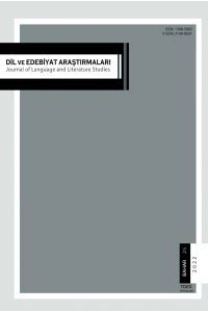Bağlama Kuramı ve Türkçedeki Kendisi Artgönderimsel İfadesine Yakından Bakış
Uzak-Ara Dönüşlü Adılları, Artgönderim, Bağlama, Dönüşlülük, İkileme
Binding Theory and a Closer Look at the Anaphoric Expression Kendisi in Turkish
Long Distance Reflexives (LDRs), Anaphora, Binding, Reflexivity, Reduplication,
___
- Aydın, Ö. (1998). İkinci dil olarak Türkçe ediniminde dönüşlü adıllara ilişkin yorumlar. XII.Dilbilim Kurultayı Bildirileri (pp. 175-186). Mersin Üniversitesi.
- Cem Değer, A. (1996). Türkçedeki dönüşlü adılların yönetici ulamlarının tanımlanması. In L. Oktar, and A. Cem Değer (Eds.), X. Dilbilim Kurultayı Bildirileri (pp. 41-47). Izmir: Ege Universitesi Basımevi.
- Chomsky, N. (1981). Lectures on Government and Binding. Dordrecht, Netherlands: Foris.
- Chomsky, N. (1982). Some Concepts and Consequences of the Theory of Government and Binding. Cambridge, Mass: MIT Press.
- Chomsky, N. (1986). Knowledge of language. New York: Praeger.
- Cole, P., & Hermon, G. (1998). Long distance reflexives in Singapore Malay: An apparent typological anomaly. Linguistic Typology 2 (1), 57-77.
- Cole, P., Hermon, G., & Huang, C.-T. J. (2001). Long Distance Reflexives -The State of the Art. In P. Cole, G. Hermon, & C.-T.J. Huang (Eds), Long Distance Reflexives. (Syntax and Semantics 33) (pp. 371–380). Academic Press: San Diego.
- Cowper, E. A. (1992). A concise introduction to syntactic theory: the Government-Binding approach. Chicago: The University of Chicago Press.
- Culicover, P. W. (1997). Principles and parameters: an introduction to syntactic theory. Oxford: Oxford University Press.
- Enç, M. (1989). Pronouns, licensing, and binding, Natural Language and Linguistic Theory, Vol.7, 51-92.
- George, L., & Kornfilt, J. (1981). Finiteness and boundedness in Turkish. In F. W. Henry (Ed.), Binding and filtering (pp. 105-127). Cambridge, Mass.: MIT
- Göksel, A., & Kerslake, C. (2005). Turkish: A comprehensive grammar. New York: Routledge.
- Gračanin-Yuksek, M., Lago, S., Şafak, D. F., Demir, O., & Kırkıcı, B. (2017). The interaction of contextual and syntactic information in the processing of Turkish anaphors. Journal of psycholinguistic research, 46(6), 1397-1425.
- Güven, M. (2015). Türkiye Türkçesindeki Kendi Biçimbiriminin İşlevlerinin Tarihsel Gelisimi Üzerine. Bilig, 72, 43-72. Haegeman, L. (1994). Introduction to Government and Binding Theory (2nd ed.). Oxford: Wiley-Blackwell Publishing.
- Harbert, W. (1995). Binding Theory, Control, and pro. In G. Webelhuth (Ed.), Government and Binding Theory and the Minimalist Program (pp. 176-240). Oxford: UK.
- Hellan, L. (1991). Containment and connectedness anaphors. In J. Koster & E. Reuland (Eds.), Long-Distance Anaphora (pp. 27-48). Cambridge: Cambridge UP.
- Kennedy, C., & Lidz. J. (2001). A (Covert) Long Distance Anaphor in English. In K. Megerdoomian & L. A. Bar-el (Eds.), WCCFL 20 Proceedings (pp. 1-14) Somerville, MA: Cascadilla Press.
- Kornfilt, J. (2001). Local and Long-Distance Reflexives in Turkish. In Peter Cole, Gabriella Hermon & C.-T. James Huang (eds.), Long Distance Reflexives (Syntax and Semantics 33) (pp. 197-226). New York: Academic Press. Koster, J., & Reuland, E. (1991). Long-Distance Anaphora. Cambridge UP.
- Meral, H. M. (2010). Some Notes on Turkish Pronominal Anaphora. Turkish Studies, vol.5, 535-563.
- Meral, H. M. (2013). Binding as an A'- Phenomenon? Evidence from Turkish. Iberia: an Intenational Journal of Theoretical Linguistics, vol.5, 45-68.
- Özbek, A., & Kahraman, B. (2016). Interpretations of Turkish reflexive pronouns kendi and kendisi. Mersin University Journal of Linguistics & Literature 13(1), 73-96.
- Özsoy, A. S. (1990). “Söylemiçi Dönüşlü Yapı.” Dilbilim Araştırmaları, 35-40.
- Palaz, B. (2010). On the nature of anaphoric expressions kendi/kendisi and the clause structure of Turkish (MA Thesis, Boğaziçi University).
- Pica, P. (1987). On the nature of the reflexivization cycle. NELS 17 (2), 483-99.
- Rakosi, G. (2009). Beyond Identity: The case of a complex Hungarian Reflexive. In M. Butt & T. Holloway King (Eds.), the Proceedings of the LFG09 Conference. (pp. 459-497). CSLI Publications.
- Reuland, E. (2017). Why is reflexivity so special? Understanding the world of reflexives. Studia linguistica, 71(1-2), 12-59.
- Rudnev, P. (2008). Some syntax and semantics of long-distance reflexives in Turkish and elsewhere. Unpublished manuscript. University of Massachusetts, Amherst, MA.
- Sezer, E. (1980). On reflexivization in Turkish, Harvard Ukrainian Studies, vol.3/4, 748-759.
- Sezer, E. (1991). Issues in Turkish Syntax. (Ph.D. Dissertation, Harvard University).
- Sezer, T. (2017). TS Corpus Project: An online Turkish Dictionary and TS DIY Corpus. European Journal of Language and Literature, 9(1), 18-24.
- Steenbergen, M. van. (1991). Long-distance binding in Finnish. In J. Koster & E. Reuland (Eds.), Long-Distance Anaphora. Cambridge UP.
- Temel, E. (2019). 14.-16. Yüzyıl Doğu Türkçesinde “Öz” ile Kurulan Sözcük Öbekleri Üzerine. Türkiyat Mecmuası, 29(1), 147-162.
- Uzunca, A. (2018). The Influence of Locality or Intimacy? A Case Study on the Issue of Reflexivization in Turkish. European Journal of Literature, Language and Linguistics Studies, 2(4), 16-36.
- Wexler, K., & Manzini, M. R. (1987). Parameters and Learnability in Binding Theory. In T. Roeper & E. Williams (Eds.), Parameter Setting (pp. 41-76). Dordrecht: D. Reidel Publishing Company.
- White, L. (2003). Second language acquisition and universal grammar. Cambridge, UK: Cambridge UP.
- Yakut, B. A. (2015). The logophoric behaviour of strict local anaphor kendi ‘self’ in Turkish. In A. Joseph & E. Predolac (Eds.), Proceedings of the 9th Workshop on Altaic Formal Linguistics, MIT Working Papers in Linguistics #76, Cambridge, MA: MITWPL.
- ISSN: 1308-5069
- Yayın Aralığı: 2
- Başlangıç: 2010
- Yayıncı: TÜRKİYE DİL VE EDEBİYAT DERNEĞİ
Sun’ullah-ı Gaybî Divan’ında Aşk Yolculuğu
Müzik-Edebiyat İlişkisinin Metinlerarası Yorumları: Aşk-ı Muhabbet Sevda
Düşsel ve Romantik: Keats’in “Lamia”sında Türsel Çeşitlilik
Çağdaş Çocuk Kitaplarında Yer Alan Aile Büyüklerinin Sunuluş Biçimleri Üzerine Bir Araştırma
Bilinmeyen Bir El Yazması Seyahatnâme: Kâtip Fâik’in “Almanya Seyahatnâmesi”
Ömer Seyfeddin’in “Mehdi ve Türbe” Hikâyelerinde Balkanlara Bakış
XIX. Yüzyıl Başları Üsküdar’ında Ekonomik ve Toplumsal Bir Güç Olarak Yeniçeriler
Dijital / Dijitalleştirilmiş Edebi Metinlerin Yabancı Dil Bilgisinin Gelişimine Katkıları
